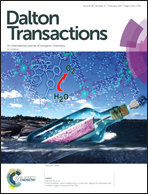CO2 as a hydrogen vector – transition metal diamine catalysts for selective HCOOH dehydrogenation†
Abstract
The homogeneous catalytic dehydrogenation of formic acid in aqueous solution provides an efficient in situ method for hydrogen production, under mild conditions, and at an adjustable rate. We synthesized a series of catalysts with the chemical formula [(Cp*)M(N–N′)Cl] (M = Ir, Rh; Cp* = pentamethylcyclopentadienyl; N–N = bidentate chelating nitrogen donor ligands), which have been proven to be active in selective formic acid decomposition in aqueous media. The scope of the study was to examine the relationship between stability and activity of catalysts for formic acid dehydrogenation versus electronic and steric properties of selected ligands, following a bottom-up approach by increasing the complexity of the N,N′-ligands progressively. The highest turnover frequency, TOF = 3300 h−1 was observed with a Cp*Ir(III) complex bearing 1,2-diaminocyclohexane as the N,N′-donor ligand. From the variable temperature studies, the activation energy of formic acid dehydrogenation has been determined, Ea = 77.94 ± 3.2 kJ mol−1. It was observed that the different steric and electronic properties of the bidentate nitrogen donor ligands alter the catalytic activity and stability of the Ir and Rh compounds profoundly.



 Please wait while we load your content...
Please wait while we load your content...